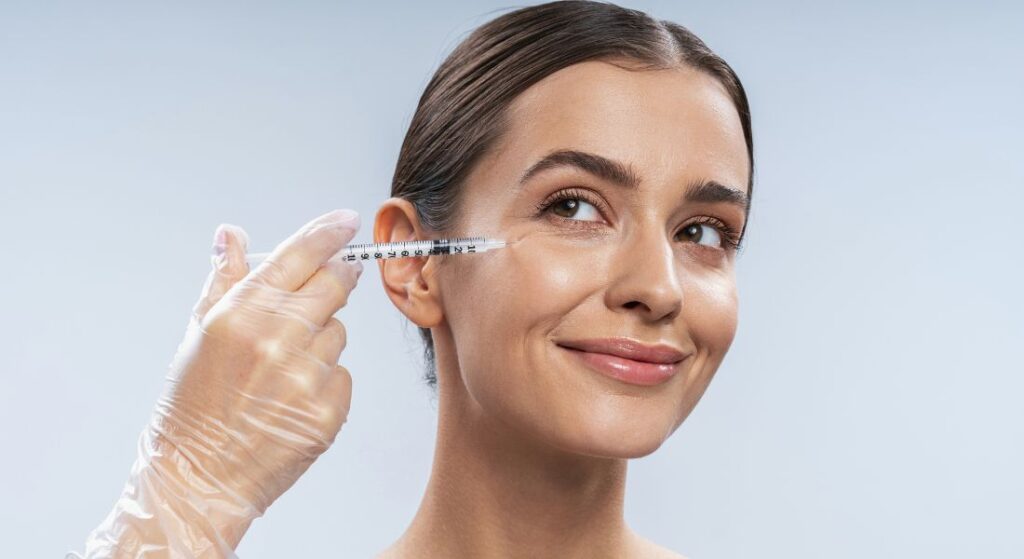
If you’re considering Sculptra, you might be wondering whether it simply restores volume or if it can actually lift your face. It’s a very common question, especially if you’ve noticed early sagging, hollowing or a gradual drop-in cheek support. You may have already tried fillers or skincare, or perhaps you’re exploring subtle ways to rejuvenate your features without looking overfilled or unnatural.
The truth is that Sculptra can create a lifting effect but not in the same way that traditional hyaluronic acid fillers or threads do. Instead, Sculptra strengthens your foundation from within, stimulating collagen that tightens, thickens and subtly elevates the tissues. In this guide, I want to explain exactly how Sculptra lifts the face, who benefits most from this type of structural support and how Sculptra compares with fillers and thread lifts so you can make an informed choice.
While it doesn’t produce an instant, dramatic lift, Sculptra works gradually, making the results look incredibly natural and in harmony with your own anatomy. As collagen builds over several months, the skin becomes firmer, the mid-face gains better support and early jowling appears softer. This makes Sculptra an ideal option for anyone who wants a refreshed, subtly lifted look that evolves slowly rather than a sudden change that others might notice immediately.
Understanding What Sculptra Really Does
Sculptra is a poly-L-lactic acid (PLLA) biostimulator.
This means it encourages your skin to produce new collagen rather than simply filling lines or hollows with gel.
How Sculptra works:
1. The injected PLLA particles trigger a controlled collagen response
2. Fibroblasts build fresh structural fibres
3. Your skin thickens and becomes firmer
4. Volume gradually restores
5. The face looks subtly lifted over time
This collagen-building process is what gives Sculptra its reputation for long-lasting, natural-looking rejuvenation.
Does Sculptra Actually Lift the Face?
Yes, Sculptra can create a lifting effect, but the lift comes from strength and support rather than “filling” or pulling.
Sculptra lifts the face by:
– Replacing deep structural volume
– Strengthening weakened areas
– Improving contour under sagging skin
– Restoring midface support
– Firming the lower face
– Reducing heaviness around the jawline
– Improving elasticity
Because the lift develops gradually, it looks extremely natural. People often comment that you look refreshed or younger not different.
Why Sculptra Creates a Lifting Effect (The Science)

1. Collagen Restores the “Scaffold” of the Face
Your face relies on a framework of collagen to maintain shape and lift.
With age, this scaffolding weakens, causing:
– Tissue descent
– Flattened cheeks
– Deepened folds
– Jowl formation
– Reduced elasticity
Sculptra rebuilds this deep support structure so the tissues sit higher.
2. Volume Replaces Hollowing That Causes Sagging
Hollowing leads to sagging because the skin has nothing to rest on.
Sculptra:
– Refills deflated areas
– Provides underlying cushion
– Lifts skin from beneath
This is particularly noticeable in the midface and temples.
3. Improved Thickness Tightens the Skin
With more collagen in the dermis, the skin becomes:
– Firmer
– Denser
– More elastic
This tightness gently lifts downward-pulling areas, especially around the lower face.
4. Sculptra Strengthens the Fascia and Deep Tissues
Sculptra is often injected into deeper planes where structural support has decreased.
This strengthens:
– Ligaments
– Fascia
– Deep fat compartments
As these structures firm up, the face looks subtly lifted.
5. Collagen Improves Jawline Definition
By restoring support above the jawline, Sculptra can reduce the appearance of early jowls.
A more defined jawline automatically creates a lifted look.
Which Areas of the Face Benefit Most From Sculptra’s Lift?

Different areas respond uniquely to Sculptra’s collagen-stimulating effects.
1. Cheeks (Midface)
Sculptra is outstanding for recreating midface fullness. When your cheeks sit higher, your entire face looks lifted.
Benefits include:
– Midface elevation
– Reduced nasolabial folds
– Smoother transition from tear trough to cheek
– Fresh, youthful contour
This is where Sculptra’s lifting effect is most noticeable.
2. Temples
Temple hollowing makes the upper face look droopy.
Sculptra restores this area, which:
– Lifts the outer brow
– Improves cheek support
– Rebalances facial proportions
A filled temple gives the face a smoother, more lifted shape.
3. Jawline
Although Sculptra doesn’t pull the jawline tight like threads, it strengthens tissue above the jawline so sagging reduces.
Benefits include:
– Softer jowls
– Clearer jaw definition
– Better facial contour
The jawline looks more refined and subtly elevated.
4. Lower Face and Marionette Area
Volume loss in the lower face often causes heaviness.
Sculptra improves:
– Marionette shadows
– Downward turn of the mouth
– Lower face laxity
This leads to a “lightened” expression and natural lift.
5. Under the Chin
Sculptra is sometimes used to improve the area under the chin by thickening the skin and subtly tightening the region.
How Sculptra’s Lift Compares With Other Treatments
Many clients ask whether Sculptra works like fillers or thread lifts.
Here’s a clear comparison.
Sculptra vs Hyaluronic Acid Fillers
HA Fillers: Instant but localised volume
Great for:
– Sharp contours
– Chin definition
– Cheek shaping
But fillers don’t lift the whole face and can look overdone if misused.
Sculptra: Structural lift through collagen
Great for:
– Overall lift
– Deep tissue support
– Natural volume
Sculptra can soften sagging more naturally than fillers because it supports, rather than simply fills.
Sculptra vs Thread Lifts
Thread Lifts: Mechanical pulling
– Immediate lift
– Precise repositioning
– Temporary results (6–12 months)
Sculptra: Biological lift
– Slow, natural improvement
– Strengthens underlying structure
– Longer-lasting results (2–3 years)
Thread lifts reposition; Sculptra reinforces.
For a full, natural lift, the two treatments can even be combined.
Sculptra vs Surgery (Facelift)
A facelift mechanically tightens tissues.
Sculptra can’t duplicate surgical results, but it can:
– Delay the need for surgery
– Improve mild to moderate sagging
– Enhance outcomes for people not ready for invasive options
If your sagging is mild, Sculptra may be enough.
How Long Does It Take to See Sculptra’s Lifting Effect?
Unlike fillers, Sculptra requires patience.
Timeline:
Weeks 1–4: Mild early improvement
Weeks 4–8: Collagen-building increases
Months 2–3: Visible volume and soft lift
Months 3–6: Peak improvement
Year 1–3: Long-lasting results
Sculptra delivers one of the most natural transformations in aesthetics.
How Many Sessions Do You Need for a Lift?
Most people need:
– 2–3 sessions,
– spaced 4–6 weeks apart,
– using 1–3 vials per session depending on age and volume loss.
Younger patients may require fewer sessions; older patients may require more for full support.
Will You Look Overfilled or Puffy?
No Sculptra is one of the safest options for avoiding a puffy or “overdone” look.
Because Sculptra builds your own collagen, the results:
– Blend seamlessly
– Feel natural
– Look subtle
– Improve gradually
It’s perfect if you’re worried about looking like you’ve had work done.
Side Effects and Safety
Common temporary effects:
– Mild swelling
– Tenderness
– Redness
– Bruising
Rare effects:
– Nodules (minimised with proper dilution and massage)
– Unevenness
– Overstimulation (very rare)
Sculptra requires an experienced injector who understands deep-tissue anatomy.
Who Is the Best Candidate for Sculptra’s Lifting Effect?

You may be an ideal candidate if:
– You want a gradual, natural lift
– You want to improve sagging
– You prefer long-lasting results
– You want structural support
– You’re noticing hollowing or tissue descent
– You dislike the look of traditional fillers
– You want a more youthful shape, not a filled appearance
Sculptra works especially well for people in their 30s, 40s, 50s and early 60s experiencing early-to-moderate sagging.
Who Is Not the Best Candidate?
Sculptra may not be ideal if:
– You want immediate results
– You want strong contouring (use fillers instead)
– You need a dramatic lift (surgery may be needed)
– You have certain autoimmune disorders
– You’re pregnant or breastfeeding
Your practitioner will advise based on your medical history.
FAQs:
1. Does Sculptra actually lift the face?
Yes, Sculptra can create a lifting effect, but the way it lifts is very different from fillers or threads. Instead of giving an instant, pulled look, Sculptra strengthens the skin and deep tissues by stimulating new collagen. As this collagen builds, it restores volume in hollow areas, improves elasticity, and reinforces the natural support structures of the face. This gradually makes the cheeks sit higher, softens jowls, and gives the overall appearance of a subtle, natural lift.
2. How soon will I see results after Sculptra?
Sculptra works slowly because it relies on your body’s collagen response. Most people notice very early changes within the first few weeks, but the real improvement becomes visible around two to three months after treatment. This is when collagen production becomes more active. The lifting effect continues to improve for several months, and the peak result is usually seen between three and six months. For this reason, Sculptra is ideal for people who want gradual, natural-looking rejuvenation rather than immediate results.
3. How long does the lifting effect of Sculptra last?
The results of Sculptra are known for being long-lasting because the treatment doesn’t rely on gel fillers it rebuilds your collagen. Most people enjoy their results for around two to three years before needing a maintenance session. Lifestyle factors like smoking, sun exposure, age, and overall skin quality can influence longevity, but Sculptra generally lasts longer than traditional hyaluronic acid fillers because it strengthens the deeper layers of the skin.
4. Can Sculptra replace a facelift?
Sculptra cannot replace a surgical facelift, especially for someone with advanced sagging, but it can provide an excellent non-surgical alternative for people with mild to moderate laxity. Instead of pulling the tissues up like surgery, Sculptra restores facial structure from within, which creates a softer, more natural lift. Many people use Sculptra to delay the need for surgery or to enhance the results of a previous facelift by improving volume and skin quality over time.
5. Is Sculptra better than fillers for lifting the face?
Sculptra and fillers work differently, so one is not necessarily better than the other it depends on your goals. Hyaluronic acid fillers create immediate volume and are great for contouring specific areas like the chin or cheekbones. Sculptra, however, offers a more global, structural lift by stimulating collagen. While fillers act like a mouldable gel, Sculptra improves the underlying support system. If you want a soft, natural lift and long-lasting improvement in firmness, Sculptra may be more suitable. If you want sculpted, sharp definition, fillers might be better.
6. How many Sculptra sessions are needed for lifting?
Most people need between two and three sessions to achieve the best lifting effect. These sessions are usually spaced four to six weeks apart to allow the collagen-building process to develop gradually. Younger patients with early signs of volume loss may need fewer sessions, while individuals with more significant hollowing or laxity may require additional vials or treatments. Your practitioner will create a personalised plan after assessing your facial structure, skin condition and ageing pattern.
7. Does Sculptra make you look overfilled or puffy?
One of the biggest advantages of Sculptra is that it avoids the overfilled, puffy appearance that can sometimes occur with excessive hyaluronic acid filler use. Because Sculptra stimulates your own collagen rather than adding an artificial substance, the results blend seamlessly into the natural contours of your face. The improvement happens slowly, so there is no dramatic or unnatural swelling. Most people simply look refreshed, firmer and subtly lifted without anyone being able to pinpoint what has changed.
8. What areas of the face respond best to Sculptra for lifting?
Sculptra works exceptionally well in areas where volume loss and weakened structure contribute to sagging. The midface is one of the most responsive regions because restoring cheek support naturally lifts the lower face. The temples also benefit greatly, as replenishing volume in this area helps lift the outer brow and improve facial balance. Sculptra can also strengthen tissues above the jawline, which reduces early jowls and enhances jawline definition. Even the lower face can appear lighter and more supported when deeper hollows are corrected.
9. What is the downtime after a Sculptra treatment?
Sculptra typically involves minimal downtime. Most people experience mild swelling, tenderness, or redness immediately after the treatment, and these effects usually settle within a couple of days. Bruising can occasionally occur but is generally mild and temporary. Unlike surgical lifts or thread lifts, Sculptra doesn’t require time off work or major aftercare, although you may be instructed to follow a short massage routine to ensure the product distributes evenly while the collagen response begins.
10. Is Sculptra safe, and who should avoid it?
Sculptra has an excellent safety profile when injected by a trained and experienced practitioner. It has been used internationally for many years and is well studied. However, it may not be suitable for people who want immediate, dramatic results or those who need precise contouring in very specific areas. Individuals with certain autoimmune conditions, active skin infections, or those who are pregnant or breastfeeding should postpone treatment. A thorough consultation is always essential to make sure Sculptra is the right choice for your aesthetic goals and medical background.
Final Thought: Is Sculptra the Right Choice for You?
Sculptra offers a unique approach to facial rejuvenation by rebuilding your skin’s natural structure rather than simply adding temporary volume. If you’re starting to notice early sagging, hollowing or a general loss of firmness, its collagen-stimulating effects can provide a subtle, long-lasting lift that looks entirely natural. For many people, it’s an ideal choice when they want meaningful improvement without the heaviness or overfilled look that can sometimes come with traditional fillers.
If you’re considering visiting a Sculptra clinic in London, you can contact us at the London Medical & Aesthetic Clinic to explore whether this treatment is the right option for your aesthetic goals and long-term facial support.
References:
1. Signori, R. et al. (2024) ‘Efficacy and Safety of Poly-L-Lactic Acid in Facial Aesthetics’, Polymers, 16(18), 2564. https://www.mdpi.com/2073-4360/16/18/2564
2. Oh, S. et al. (2023) ‘Poly-L-Lactic Acid Fillers Improve Dermal Collagen via M2 Macrophage Polarisation’, Cells, 12(9), 1320. https://www.mdpi.com/2073-4409/12/9/1320
3. Munia, C. et al. (2022) ‘Changes in Facial Morphology Using Poly-L-Lactic Acid and the Vector Technique’, Journal of Cosmetic Dermatology. https://www.ncbi.nlm.nih.gov/pmc/articles/PMC9345188/
4. Christen, M.-O. (2022) ‘A Review Focused on Poly-L-Lactic Acid (PLLA)’, Clinical, Cosmetic and Investigational Dermatology. https://www.ncbi.nlm.nih.gov/pmc/articles/PMC9233565/
5. Arruda, S. et al. (2024) ‘A Clinical Histology Study Evaluating the Biostimulatory Activity Longevity of Injectable Poly-L-Lactic Acid for Facial Rejuvenation’, Journal of Drugs in Dermatology, 23(9), pp.729–734. https://pubmed.ncbi.nlm.nih.gov/39355824/





